Friday, September 15, 2006
FRIDAY, AUGUST 25th TRAVEL TO SPAIN
We arrived back in Dublin late in the afternoon on Thursday. We had a very pleasant drive until we were in about fifteen miles of the city. The four lane ended and we got off into construction and surface streets. At one point it took us forty five minutes to go a couple of miles. I was glad to get back to the car rental agency at the airport and get back on public transportation. We took a bus down into the city and went to our hotel. We spent the night then took a taxi to the ferry terminal at Don Laoghaire. We just reversed our trip from this point. We took the ferry to Hollyhead in Wales. We went by train from Holleyhead to London where we had to change train stations to get a train to Dover.
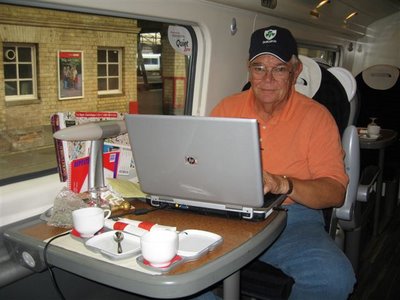
We went by underground from Euston Station to Victoria Station and caught a train to Dover where we planned to take a night ferry across the English Channel to Calais, France.
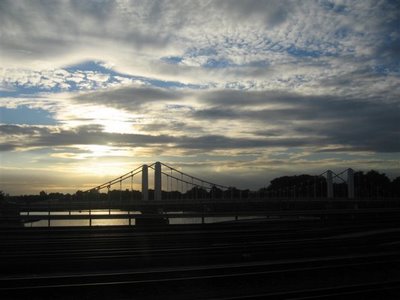
All plans have a weakness. When we arrived at the Dover Ferry Port it was about 11:00 pm. We found that the ferry company had discontinued their foot passenger service from 9:00 pm until 6:00 am. We were stuck in the terminal for the night. We could have taken a taxi back into the city of Dover and tried to find a hotel; however, at that time of night paying a taxi to haul us around in search of a room did not seem like a good idea. They had very comfortable chairs and couches in the arrivals lounge at the ferry terminal so joined a lot of other people who evidently were in the same situation as us and slept in the waiting room.
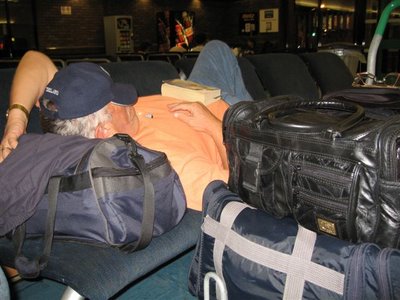
I questioned the people at the desk about the incorrect time schedule I had which did not show the stoppage of night service. The response was that they just hadn’t gotten around to reprinting the time schedules. The night service had been stopped for ten months. I was a little bit unhappy with them.
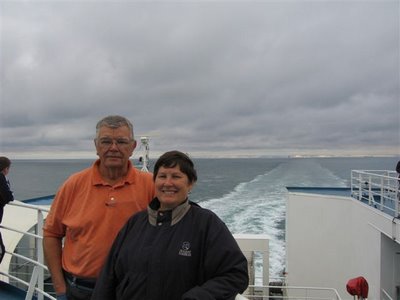
This delay caused us to arrive in Barcelona, Spain early on Sunday morning instead of mid afternoon on Saturday. We rented a car and drove about an hour and a half to our timeshare accommodations for the week.
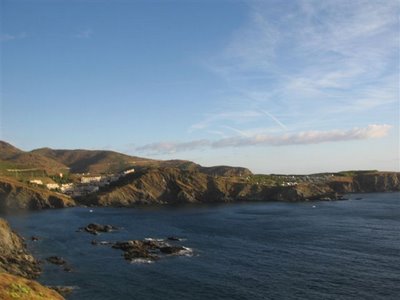
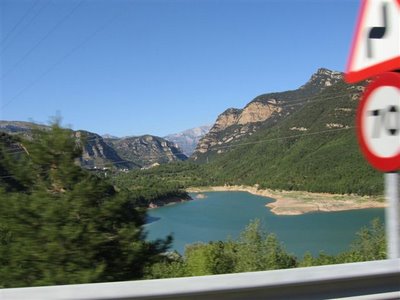
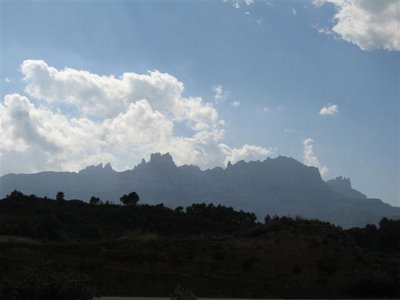
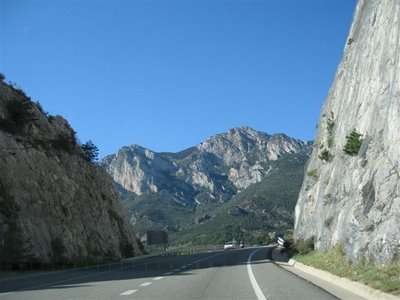
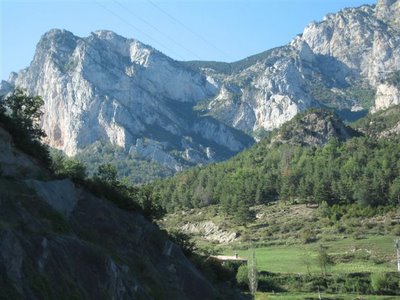
We had a room in a hotel in a small village of Bellver de Cardanya. We were fortunate that the wife in the couple who ran the hotel had a British Mom and she knew how to speak English. There were not a lot of people in that region of Spain who spoke English. Most of them spoke Spanish, some spoke French, but the official language was Catalonian which is some kind of a mixture of Spanish and French. Even when we got back to Barcelona we did not find a lot of people who spoke English.
We stayed at this hotel from Sunday afternoon until Wednesday morning. It is located in a beautiful valley in the Pyrenees Mountains.
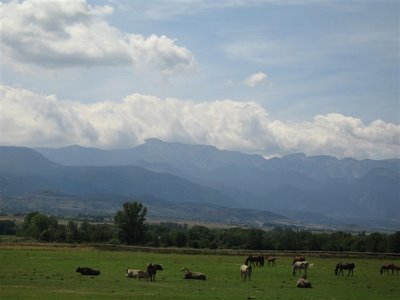
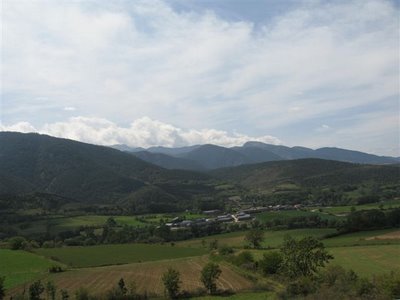
Our hotel was located literally next door to a 12th Century church named The Church of Santa Maria de Tallo. We went inside the church one evening when there was some sort of service or meeting going on up front.
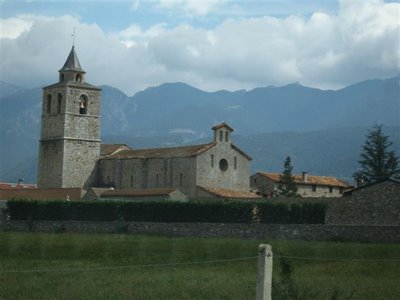
We were with another couple and we just sat down on the back seat and took a look at the building. There is a carved wood statue of the Virgin which is the same age as the church. They date back to sometime in the 1100’s.
Our landlords were a young couple who had moved up into the mountains from Barcelona. They wanted to manage a Bed and Breakfast so they took a second lease on this hotel and were doing a very good job with it. It was small and very old Europe.
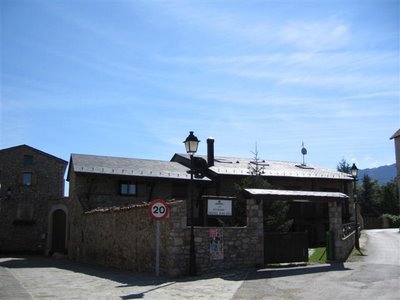
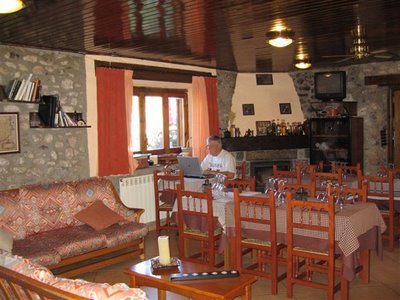
She took care of the front office and even helped with the housecleaning. He is a gourmet cook and turned out good meals. Their names were Daniel and Rebecca and we got to be good friends with them.
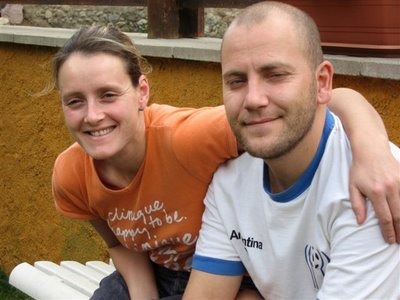
Daniel didn’t speak any English, but Rebecca and Mary became good enough friends that we know a lot of the problems involved in running a hotel. We met a very nice couple from Australia and exchanged email addresses. We plan to stay in touch with them, because if we stay healthy and don’t go broke we plan to go to Australia in the near future.
While we were in the mountains we went to another small town nearby named Puigcerda. We went there looking for a Laundromat. No luck; we haven’t seen a Laundromat since we left Ireland. What we found was a real nice little town with great shops and restaurants.

In the village center is Santa Maria Placa. It is a square with an old bell tower which is all that is left of The Church of Santa Maria. The church was destroyed during the Spanish Civil War. The town was founded in 1171 and the bell tower is about that age. Most of the buildings are newer than that but you can tell by the width of the streets and some of the buildings that the city is old.
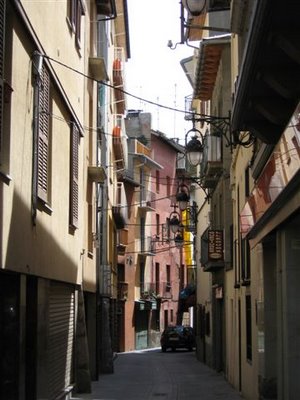
We had lunch there a couple of days at little outdoor cafes. We really enjoy the local foods and atmosphere. We can usually find a server to help us with the menu if they don’t have an English version.
On Thursday, August 31st we left the mountains and headed for Barcelona. We had planned a blitz of Barcelona, Madrid and Lisbon, Portugal. We got to Barcelona mid morning and returned our rental car. We also had to take some time to go shopping. Mary’s digital camera died. It was only a year old and we did not understand why it quit. I told Mary that it was probably only designed to take two million pictures and she had easily exceeded that in the last year. I guess we will get Cannon to look at it when we get back to the US. We then took a city tour on an open topped double-decker bus. About ten o’clock Thursday night we caught a sleeper train and went to Madrid. We arrived there early on Friday morning and spent the day touring and sightseeing in Madrid. At about 11:00 we boarded a sleeper train and went to Lisbon. We arrived in Lisbon early morning and spent the day touring and sightseeing on Saturday. Saturday night we took a sleeper train back to Madrid. On Sunday morning we got a train from Madrid back to Barcelona and had a sleeper scheduled for Sunday night to Torino, Italy. That is a real whirlwind, but the sleeper compartments on the trains are comfortable and they are, in most cases, less expensive than a motel would be. We arrived rested and ready for another day of sightseeing. The only disadvantage to traveling like this is you misses seeing the country between the cities. We enjoy the trip as much as we do getting there.
The first tour we took was in Barcelona and it is a beautiful city. The narrative which was so fast and the Spanish accented English kept me from getting too many of the facts. We have a lot of beautiful pictures, but we are not sure what they are.
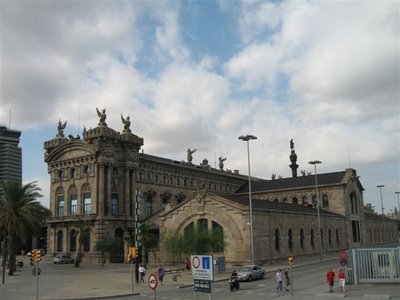
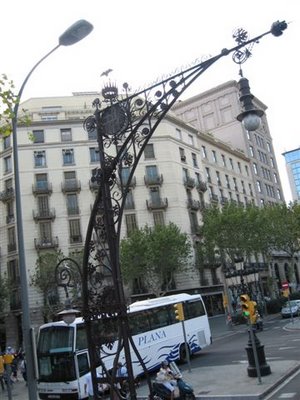
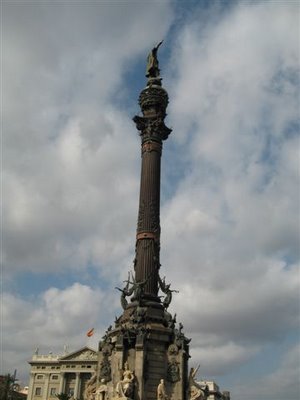
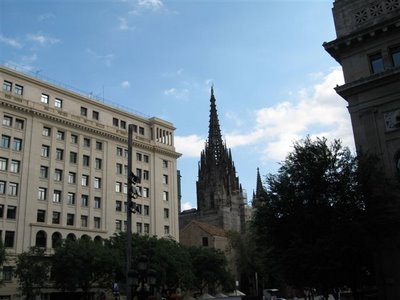

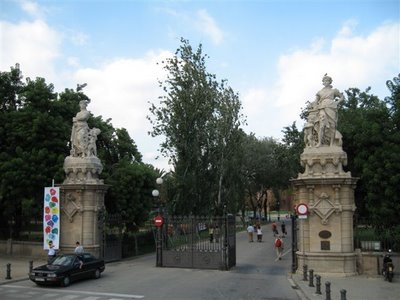
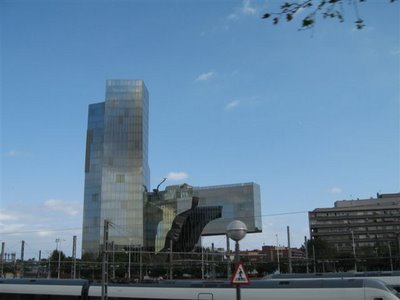
I do know that it is a major port on the Mediterranean Sea. Also there are a lot of improvements which came from the Olympics being there a few years back.
The next day in Madrid we were on a tour that had such poor sound on their headphones that we got nothing from it. Again, Madrid is beautiful old city which dates back to 711 AD. There have been a variety of influences on the growth of the city and it has been capitol of Spain since 1516.
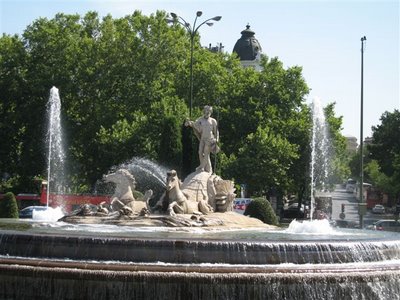
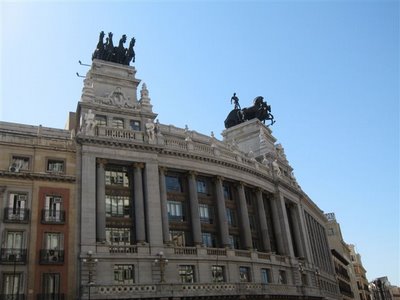
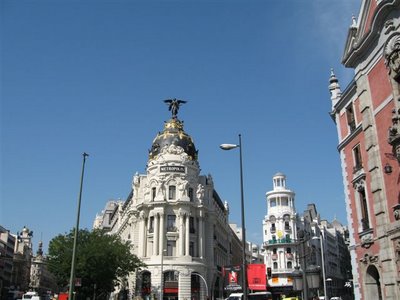
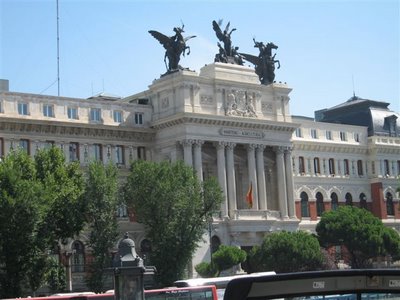
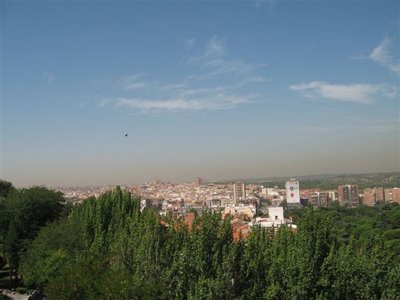
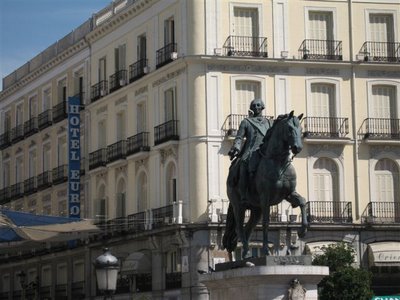
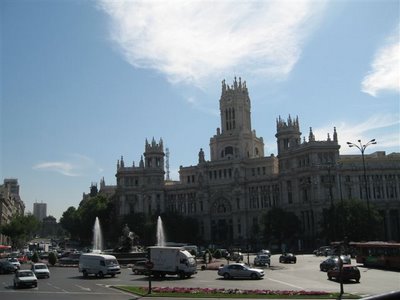
It is sometime referred to as the European Jerusalem because of the mix of Christians, Jews and Muslims. Mary and I decided that we will not have much text from those two days so we will just put in a bunch of our favorite pictures.
We had a great tour in Lisbon. At first glance Lisbon appears to be a third world city. It looks ragged, dirty and in bad need of repair. That is the old city. When we got into the newer area of the city it was a lot better looking. We bought a ticket which allowed us to ride the public transportation and the take all the tours which they offered. We rode a city bus down the Plaza de Commerical where the tours were staged, the square was built in the mid 1600 and serves as government offices today.
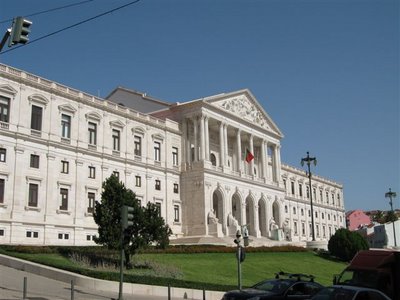
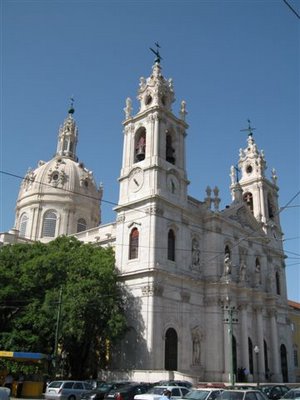
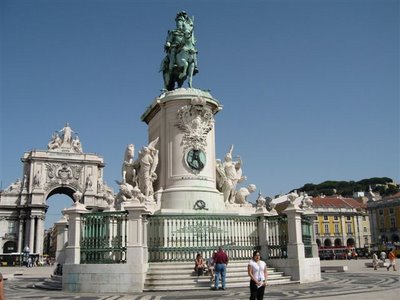
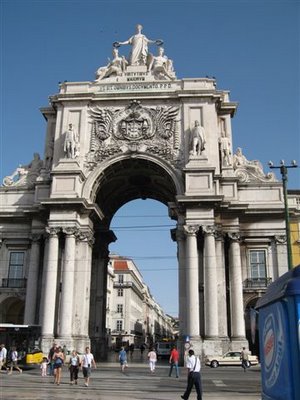
We first took a Tram tour which was electric and ran on tracks. It covered the old city. It would have been impossible to have used a bus for the tour because of the narrow streets. There were times when a car would park in the street and the tram driver would just have to sit and blow his horn until someone came and moved the car.
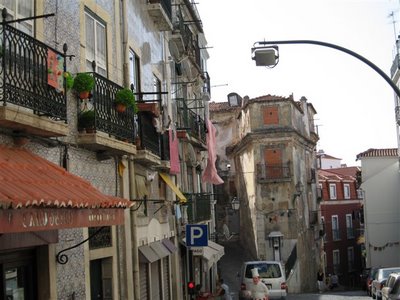
As most of the old sections in European cities, the narrow streets open to squares or plazas and the streets have no systematic design, but just ramble in any direction. This situation was made more extreme because of the hills in the city.

They claim, like Rome, to be built on seven hills. The buildings in the old city reflect the many influences on Portugal due to their empire building in their early history. There are Moorish, African, Arab, as well as Spanish styles scattered throughout the city. The neighborhoods are ethnic and the shopping reflects the ethnic makeup of the neighborhood it serves. A lot of the buildings and the side walks have tile siding.
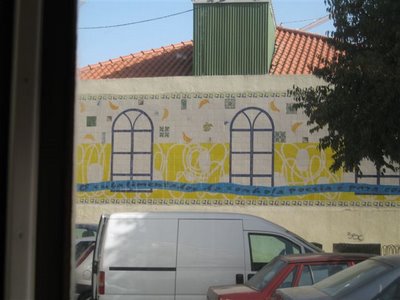
It came from the Moorish influence and is decorative, but it serves well as insulation and is very low maintaince.
There is a section of the old city which has Moorish roots and has provided homes and entertainment for many of the artists, writers and musicians of the culture. AlFama is the name of the area and it is the name given to the music which has come to be identified as the national music of Portugal. Played on a twelve string guitar it has a very distinctive sound.
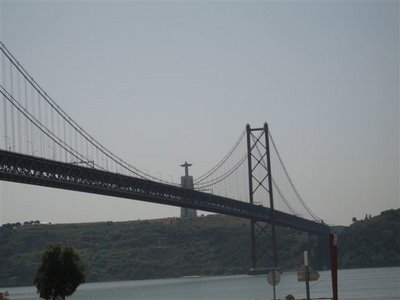
In 1986 Portugal joined the European Union. Since then billions of dollars have been invested in Portugal and it has gone from being one of the poorest countries in Europe to having the highest economic growth rate of any country in Europe. This more modern economy has benefited Portugal, but it has also widened the gap between the rich and the poor.
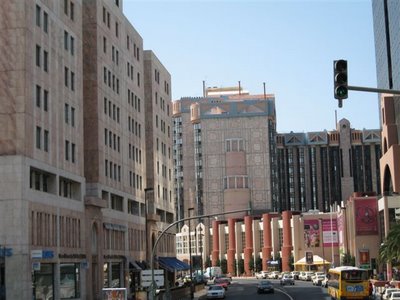
Portugal continues to be a sea going nation and Lisbon is a great port, however, in the recent past efforts have been made to develop an industrial economy and shore up the agricultural economy. The difference which has been made by membership in the EU is readily apparent in the construction within the business community in the last twenty years.
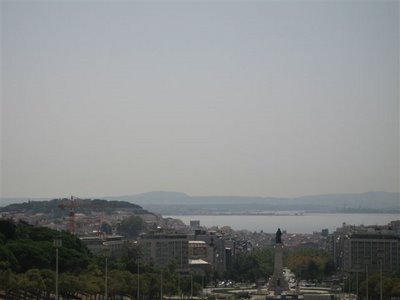
In the time we spent in Lisbon there is no way to grasp the culture and the spirit of the city. I believe that Lisbon will continue to rise in the ranks of Capitol cities of the world. We have completed our blitz. We are ready to return to Barcelona so we can get our connection to Torino and spend some time in Italy. We came back from Lisbon on a sleeper train. We arrived in Madrid early on Sunday morning and took a train from there to Barcelona.
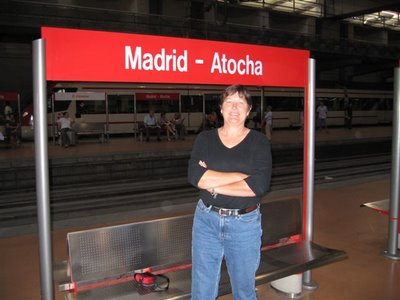
This was all country which we had slept through on our trip to Madrid from Barcelona, so we got a chance to see some new country. It is dry and rugged hills and mountains. Any agricultural endeavors were irrigated. There was a considerable amount of farming, especially grapes and fruit trees.
We got back to Barcelona in early afternoon and were not scheduled to leave there until 8:40 that night on a sleeper to Turino in Italy. While we were waiting I set us up in the lobby of the station to do some work on the computer. I piled up some bags and set to work. We took turns working and when it got to be suppertime I went to eat and Mary stayed with the luggage and worked with her pictures. After I had eaten Mary went to eat and I stayed there and worked on my journal.
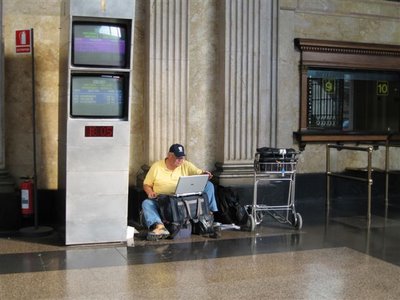
When Mary came back she was looking for her small carry on bag and it was gone. While I was distracted by the typing of my journal someone came by and lifted Mary’s bag. It had her purse in it so she lost all her ID including her passport. We also lost all of the credit cards, driver’s license, SS card, and even a credit card sized copy of her birth certificate. Needless to say we missed out train to Italy.
It was Sunday before Labor Day so the US Consulate was not open the next day because of the holiday. We had to wait until Tuesday morning to get Mary a new passport, so it was Tuesday night before we got out of Barcelona.
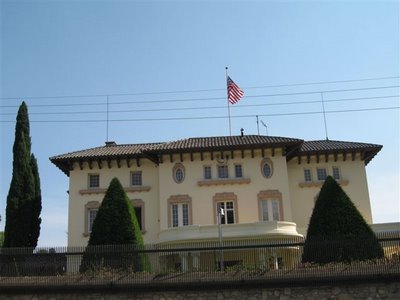
We reconsidered our position and decided that we would not rent a car and go to our timeshare. We called and cancelled our reservation there and made reservations for Wednesday night in Venice and Thursday and Friday nights in Florence. We stayed in a hostel which was a five minute walk from the Consulate. We badly need to do laundry, but we could not find a Laundromat. On the roof terrace there was an outdoor laundry area and Mary did our laundry by hand and hung it on the line. It has been a long time since we did that.
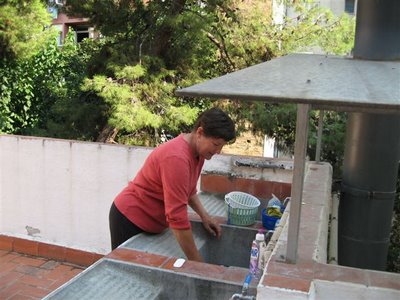
The front edge of the concrete tub was ribbed and made into a rub board, and there was a wash tub and a rinse tub. We had a good time with that. We also had a very pleasant supper of crackers, cheese, fruit and a good pastry, which we bought at a deli up the street.
Barcelona is a beautiful city, but we were glad to get to Italy.
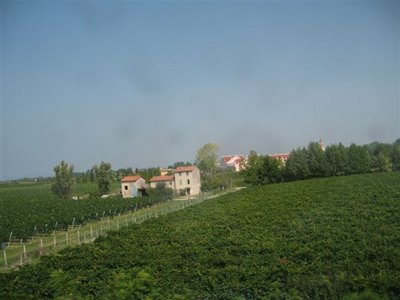
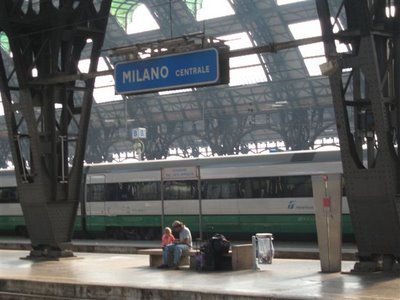
We arrived back in Dublin late in the afternoon on Thursday. We had a very pleasant drive until we were in about fifteen miles of the city. The four lane ended and we got off into construction and surface streets. At one point it took us forty five minutes to go a couple of miles. I was glad to get back to the car rental agency at the airport and get back on public transportation. We took a bus down into the city and went to our hotel. We spent the night then took a taxi to the ferry terminal at Don Laoghaire. We just reversed our trip from this point. We took the ferry to Hollyhead in Wales. We went by train from Holleyhead to London where we had to change train stations to get a train to Dover.

We went by underground from Euston Station to Victoria Station and caught a train to Dover where we planned to take a night ferry across the English Channel to Calais, France.

All plans have a weakness. When we arrived at the Dover Ferry Port it was about 11:00 pm. We found that the ferry company had discontinued their foot passenger service from 9:00 pm until 6:00 am. We were stuck in the terminal for the night. We could have taken a taxi back into the city of Dover and tried to find a hotel; however, at that time of night paying a taxi to haul us around in search of a room did not seem like a good idea. They had very comfortable chairs and couches in the arrivals lounge at the ferry terminal so joined a lot of other people who evidently were in the same situation as us and slept in the waiting room.

I questioned the people at the desk about the incorrect time schedule I had which did not show the stoppage of night service. The response was that they just hadn’t gotten around to reprinting the time schedules. The night service had been stopped for ten months. I was a little bit unhappy with them.

This delay caused us to arrive in Barcelona, Spain early on Sunday morning instead of mid afternoon on Saturday. We rented a car and drove about an hour and a half to our timeshare accommodations for the week.





We had a room in a hotel in a small village of Bellver de Cardanya. We were fortunate that the wife in the couple who ran the hotel had a British Mom and she knew how to speak English. There were not a lot of people in that region of Spain who spoke English. Most of them spoke Spanish, some spoke French, but the official language was Catalonian which is some kind of a mixture of Spanish and French. Even when we got back to Barcelona we did not find a lot of people who spoke English.
We stayed at this hotel from Sunday afternoon until Wednesday morning. It is located in a beautiful valley in the Pyrenees Mountains.


Our hotel was located literally next door to a 12th Century church named The Church of Santa Maria de Tallo. We went inside the church one evening when there was some sort of service or meeting going on up front.

We were with another couple and we just sat down on the back seat and took a look at the building. There is a carved wood statue of the Virgin which is the same age as the church. They date back to sometime in the 1100’s.
Our landlords were a young couple who had moved up into the mountains from Barcelona. They wanted to manage a Bed and Breakfast so they took a second lease on this hotel and were doing a very good job with it. It was small and very old Europe.


She took care of the front office and even helped with the housecleaning. He is a gourmet cook and turned out good meals. Their names were Daniel and Rebecca and we got to be good friends with them.

Daniel didn’t speak any English, but Rebecca and Mary became good enough friends that we know a lot of the problems involved in running a hotel. We met a very nice couple from Australia and exchanged email addresses. We plan to stay in touch with them, because if we stay healthy and don’t go broke we plan to go to Australia in the near future.
While we were in the mountains we went to another small town nearby named Puigcerda. We went there looking for a Laundromat. No luck; we haven’t seen a Laundromat since we left Ireland. What we found was a real nice little town with great shops and restaurants.

In the village center is Santa Maria Placa. It is a square with an old bell tower which is all that is left of The Church of Santa Maria. The church was destroyed during the Spanish Civil War. The town was founded in 1171 and the bell tower is about that age. Most of the buildings are newer than that but you can tell by the width of the streets and some of the buildings that the city is old.

We had lunch there a couple of days at little outdoor cafes. We really enjoy the local foods and atmosphere. We can usually find a server to help us with the menu if they don’t have an English version.
On Thursday, August 31st we left the mountains and headed for Barcelona. We had planned a blitz of Barcelona, Madrid and Lisbon, Portugal. We got to Barcelona mid morning and returned our rental car. We also had to take some time to go shopping. Mary’s digital camera died. It was only a year old and we did not understand why it quit. I told Mary that it was probably only designed to take two million pictures and she had easily exceeded that in the last year. I guess we will get Cannon to look at it when we get back to the US. We then took a city tour on an open topped double-decker bus. About ten o’clock Thursday night we caught a sleeper train and went to Madrid. We arrived there early on Friday morning and spent the day touring and sightseeing in Madrid. At about 11:00 we boarded a sleeper train and went to Lisbon. We arrived in Lisbon early morning and spent the day touring and sightseeing on Saturday. Saturday night we took a sleeper train back to Madrid. On Sunday morning we got a train from Madrid back to Barcelona and had a sleeper scheduled for Sunday night to Torino, Italy. That is a real whirlwind, but the sleeper compartments on the trains are comfortable and they are, in most cases, less expensive than a motel would be. We arrived rested and ready for another day of sightseeing. The only disadvantage to traveling like this is you misses seeing the country between the cities. We enjoy the trip as much as we do getting there.
The first tour we took was in Barcelona and it is a beautiful city. The narrative which was so fast and the Spanish accented English kept me from getting too many of the facts. We have a lot of beautiful pictures, but we are not sure what they are.







I do know that it is a major port on the Mediterranean Sea. Also there are a lot of improvements which came from the Olympics being there a few years back.
The next day in Madrid we were on a tour that had such poor sound on their headphones that we got nothing from it. Again, Madrid is beautiful old city which dates back to 711 AD. There have been a variety of influences on the growth of the city and it has been capitol of Spain since 1516.







It is sometime referred to as the European Jerusalem because of the mix of Christians, Jews and Muslims. Mary and I decided that we will not have much text from those two days so we will just put in a bunch of our favorite pictures.
We had a great tour in Lisbon. At first glance Lisbon appears to be a third world city. It looks ragged, dirty and in bad need of repair. That is the old city. When we got into the newer area of the city it was a lot better looking. We bought a ticket which allowed us to ride the public transportation and the take all the tours which they offered. We rode a city bus down the Plaza de Commerical where the tours were staged, the square was built in the mid 1600 and serves as government offices today.




We first took a Tram tour which was electric and ran on tracks. It covered the old city. It would have been impossible to have used a bus for the tour because of the narrow streets. There were times when a car would park in the street and the tram driver would just have to sit and blow his horn until someone came and moved the car.

As most of the old sections in European cities, the narrow streets open to squares or plazas and the streets have no systematic design, but just ramble in any direction. This situation was made more extreme because of the hills in the city.

They claim, like Rome, to be built on seven hills. The buildings in the old city reflect the many influences on Portugal due to their empire building in their early history. There are Moorish, African, Arab, as well as Spanish styles scattered throughout the city. The neighborhoods are ethnic and the shopping reflects the ethnic makeup of the neighborhood it serves. A lot of the buildings and the side walks have tile siding.

It came from the Moorish influence and is decorative, but it serves well as insulation and is very low maintaince.
There is a section of the old city which has Moorish roots and has provided homes and entertainment for many of the artists, writers and musicians of the culture. AlFama is the name of the area and it is the name given to the music which has come to be identified as the national music of Portugal. Played on a twelve string guitar it has a very distinctive sound.

In 1986 Portugal joined the European Union. Since then billions of dollars have been invested in Portugal and it has gone from being one of the poorest countries in Europe to having the highest economic growth rate of any country in Europe. This more modern economy has benefited Portugal, but it has also widened the gap between the rich and the poor.

Portugal continues to be a sea going nation and Lisbon is a great port, however, in the recent past efforts have been made to develop an industrial economy and shore up the agricultural economy. The difference which has been made by membership in the EU is readily apparent in the construction within the business community in the last twenty years.

In the time we spent in Lisbon there is no way to grasp the culture and the spirit of the city. I believe that Lisbon will continue to rise in the ranks of Capitol cities of the world. We have completed our blitz. We are ready to return to Barcelona so we can get our connection to Torino and spend some time in Italy. We came back from Lisbon on a sleeper train. We arrived in Madrid early on Sunday morning and took a train from there to Barcelona.

This was all country which we had slept through on our trip to Madrid from Barcelona, so we got a chance to see some new country. It is dry and rugged hills and mountains. Any agricultural endeavors were irrigated. There was a considerable amount of farming, especially grapes and fruit trees.
We got back to Barcelona in early afternoon and were not scheduled to leave there until 8:40 that night on a sleeper to Turino in Italy. While we were waiting I set us up in the lobby of the station to do some work on the computer. I piled up some bags and set to work. We took turns working and when it got to be suppertime I went to eat and Mary stayed with the luggage and worked with her pictures. After I had eaten Mary went to eat and I stayed there and worked on my journal.

When Mary came back she was looking for her small carry on bag and it was gone. While I was distracted by the typing of my journal someone came by and lifted Mary’s bag. It had her purse in it so she lost all her ID including her passport. We also lost all of the credit cards, driver’s license, SS card, and even a credit card sized copy of her birth certificate. Needless to say we missed out train to Italy.
It was Sunday before Labor Day so the US Consulate was not open the next day because of the holiday. We had to wait until Tuesday morning to get Mary a new passport, so it was Tuesday night before we got out of Barcelona.

We reconsidered our position and decided that we would not rent a car and go to our timeshare. We called and cancelled our reservation there and made reservations for Wednesday night in Venice and Thursday and Friday nights in Florence. We stayed in a hostel which was a five minute walk from the Consulate. We badly need to do laundry, but we could not find a Laundromat. On the roof terrace there was an outdoor laundry area and Mary did our laundry by hand and hung it on the line. It has been a long time since we did that.

The front edge of the concrete tub was ribbed and made into a rub board, and there was a wash tub and a rinse tub. We had a good time with that. We also had a very pleasant supper of crackers, cheese, fruit and a good pastry, which we bought at a deli up the street.
Barcelona is a beautiful city, but we were glad to get to Italy.


WEDNESDAY, AUGUST 23rd—RING OF KERRY
We got up early today and drove back down to Killarney to start the drove around the Ring of Kerry just south of there. As is usual we had a rainy drab morning to start what turned out to be a special day of sight seeing. On our drive to Killarney, Mary had to stop in a small town named Adare to get some pictures of some of the houses with thatched roofs and a pretty old church. Mary is fascinated by the thatched roofs on some of the buildings here.
I’m going to borrow from a brochure a description of what the Ring of Kerry is. The Ring O Kerry affords a panoramic drive through some of County Kerry’s most outstanding scenery around the Iveragh Peninsula. The route of the Ring travels through Killorglin beside the River Laune, Caragh Lake and on to Glenbeigh where we got our first glimpse of the Atlantic Ocean at Rossbeigh. It goes South along the shores of Dingle Bay to Kells. Nearby the Skelling Experience Center is located and Ballinskelling is not too far away.
We continued on to Waterville and along the coast via the Coomakista Pass and Derrynane to Sneem. From there we drove along the shores of Kenmare Bay into Kenmare town. From there we went back to Killarney via Molls Gap and Ladies View where we got great views of the famous Lakes of Killarney.
Along this route we stopped for some of the touristy stuff, and we just stopped for a lot of the pretty stuff.
Our first stop on the Ring was at Glenbeigh. Just south of the town is the Kerry Bog Village Museum. Their claim is that they had moved actual structures to the sit and recreated a typical village. They had several levels of socio-economic dwellings. At the lower end of the scale there is the stable dwelling of the small poor farmers. Half of the house was set aside for humans and the other half was reserved for animals. It kept the amimals in out of the cold and their body heat helped to warmth area. The rear door of the house was raised so the dropping of the animals could just be swept out side.
The next level was for laborers. It is a very basic structure with dirt floors and an open fire place with a wooden chimney. These cottages were built by the community and the laborers were like handyman type folks. They lived in the cottages and helped the craftsmen upon request. He received no pay for his labor, instead he got his keep.
The turf cutters house was a level above the laborer dwellings. These houses would most likely have stone floors and at least two rooms. They had storage for the tools of the home owner’s trade and were usually well built dry and very warm. The one we saw as an example actually had a peat fire in the fireplace.
The highest level in the class structure of the villages was the Thatcher’s dwelling. He was usually the wealthiest man in the village, because he had a trade and was a craftsman. At that time all the houses were thatched. Some people tried to do their own, but if you could afford it you hired a Thatcher. The house we saw had more room and better furnishings in the living area. More and better dishes and utensils in the kitchen and there was a sleeping loft above the bedroom with two more beds there.
Depending on the accuracy to the dwellings shown there was a distinct difference in the standard of living. In the village there was also a blacksmith shop, barn with animals and a chicken house with chickens. The cows were the famous Black Kerry Cows. The next day Mary went to a pasture where there were some of the cows to take a picture. She met a lady and while visiting with her she told the lady what she was doing. The lady asked, “Do you mean the Blue Kerry Coos”. Mary didn’t realize what she had said until she was telling me about it later.
In the village they had a lot of really neat old tools. There were piles of peat at each house. We were told that the peat in their bog was estimated to be 35,000 years old. Peat is the left overs of plant material which caught up in low boggy areas and over the centuries decayed and grew most on top. It continued the process until there is a good level of peat which is cut out of the ground in squares like sod, only smaller. It is used as fuel to heat and cook. It does burn warm; however, it does not smell very good if the chimney is drawing well. I guess it beats cow chips and buffalo chips like they burned on the American plains. There was a machine used to cut the peat into the size block required for the type of fire you needed. It was a wheel with two blades on it. You turn the wheel and some teeth pull the peat through and the blades slice of the amount of the settings. The y had carts and wheelbarrows with wooden block wheels and a lot of old farm machines like plows, planters and mowers.
This was an interesting stop for us. It did give an idea of the style of living in the early 1600’s. I would think that it had not progressed a great deal until the late 1800’s in the US. One event which was a big deal in the region was the Puck Fair. The Puck, (male goat), is by their legend a symbol of fertility and the fair grew up in the 1500’s and continues today There are written records as early as 1603 of the Kings permission of the city to charge a fee for each goat brought to the fair.
As we continued on our trip we passed through the McGillycuddy Reeks which are a range of low but beautifully rugged mountains. At Rossbeigh we saw the Atlantic Ocean for the first time off of Irish shores. We followed the coast up and over the Coomkista Pass which rises 700 feet above the shore line and give some really great views of the Irish coast on the Atlantic. We stopped at a viewing point and took some great pictures. On our way down the other side we stopped at a small deli on a cliff overlooking the ocean and bought us a picnic lunch. They had tables outside and we ate there even though it was a pretty good struggle.
After lunch we made another viewing stop and while we were there we met a young couple and visited with them for awhile. The man was born in Americus, GA, and his wife was from some small town in MS. They were changing jobs and moving to Virginia so they took an Irish vacation on the way. They were having as much fun as we were. They told us about an old fort which they had visited at Castlecove. We had read about it and we wanted to stop there anyway so we did. The fort dated back about 2500 years. The community of peasants which worked the land depended on the protection of the nobleman who controlled them. In time of danger they entered the fort. The area was about 30 yards in diameter and was almost a circle. The walls were 18 feet high on the north side where they were at their full height, and they were 13 feet thick at the base and about 7 feet thick at the top. They were made from native stone and were stacked without any mortar. The stacked were shaped into stairs which reached up to flat areas where the defenders could stand. There were small chambers built into the wall for storage. I read that inside the walls they built what was called bee hive houses to use during a siege. There was no evidence of these.
We spent so much time on the Ring of Kerry that we had to cancel our plans to go to Galway. We found a hostel in Muckross, which is just south of Killarny. It was an old farm and the guy who owned it had run a hostel there since 1979. His wife had died and his daughter lived there and helped him run the business. It was on top of a mountain and just had a one lane road for about two miles. We had never stayed in a dorm at a hostel. Here we stayed in a large room with four sets of bunk beds. Our roommates were two French girls and a Family with two kids about 8-12 years old. There was a common kitchen and you could bring in food and cook if you wished. We got in late, went to town to a hotel and used their wireless internet and ate dinner in their restraint and then went back out there to sleep. We left early the next morning. It was a different experience, but it was OK. The next morning was Thursday and we had reservations in Dublin that night so we could leave Ireland on Friday we drove directly back to Dublin.
We got up early today and drove back down to Killarney to start the drove around the Ring of Kerry just south of there. As is usual we had a rainy drab morning to start what turned out to be a special day of sight seeing. On our drive to Killarney, Mary had to stop in a small town named Adare to get some pictures of some of the houses with thatched roofs and a pretty old church. Mary is fascinated by the thatched roofs on some of the buildings here.
I’m going to borrow from a brochure a description of what the Ring of Kerry is. The Ring O Kerry affords a panoramic drive through some of County Kerry’s most outstanding scenery around the Iveragh Peninsula. The route of the Ring travels through Killorglin beside the River Laune, Caragh Lake and on to Glenbeigh where we got our first glimpse of the Atlantic Ocean at Rossbeigh. It goes South along the shores of Dingle Bay to Kells. Nearby the Skelling Experience Center is located and Ballinskelling is not too far away.
We continued on to Waterville and along the coast via the Coomakista Pass and Derrynane to Sneem. From there we drove along the shores of Kenmare Bay into Kenmare town. From there we went back to Killarney via Molls Gap and Ladies View where we got great views of the famous Lakes of Killarney.
Along this route we stopped for some of the touristy stuff, and we just stopped for a lot of the pretty stuff.
Our first stop on the Ring was at Glenbeigh. Just south of the town is the Kerry Bog Village Museum. Their claim is that they had moved actual structures to the sit and recreated a typical village. They had several levels of socio-economic dwellings. At the lower end of the scale there is the stable dwelling of the small poor farmers. Half of the house was set aside for humans and the other half was reserved for animals. It kept the amimals in out of the cold and their body heat helped to warmth area. The rear door of the house was raised so the dropping of the animals could just be swept out side.
The next level was for laborers. It is a very basic structure with dirt floors and an open fire place with a wooden chimney. These cottages were built by the community and the laborers were like handyman type folks. They lived in the cottages and helped the craftsmen upon request. He received no pay for his labor, instead he got his keep.
The turf cutters house was a level above the laborer dwellings. These houses would most likely have stone floors and at least two rooms. They had storage for the tools of the home owner’s trade and were usually well built dry and very warm. The one we saw as an example actually had a peat fire in the fireplace.
The highest level in the class structure of the villages was the Thatcher’s dwelling. He was usually the wealthiest man in the village, because he had a trade and was a craftsman. At that time all the houses were thatched. Some people tried to do their own, but if you could afford it you hired a Thatcher. The house we saw had more room and better furnishings in the living area. More and better dishes and utensils in the kitchen and there was a sleeping loft above the bedroom with two more beds there.
Depending on the accuracy to the dwellings shown there was a distinct difference in the standard of living. In the village there was also a blacksmith shop, barn with animals and a chicken house with chickens. The cows were the famous Black Kerry Cows. The next day Mary went to a pasture where there were some of the cows to take a picture. She met a lady and while visiting with her she told the lady what she was doing. The lady asked, “Do you mean the Blue Kerry Coos”. Mary didn’t realize what she had said until she was telling me about it later.
In the village they had a lot of really neat old tools. There were piles of peat at each house. We were told that the peat in their bog was estimated to be 35,000 years old. Peat is the left overs of plant material which caught up in low boggy areas and over the centuries decayed and grew most on top. It continued the process until there is a good level of peat which is cut out of the ground in squares like sod, only smaller. It is used as fuel to heat and cook. It does burn warm; however, it does not smell very good if the chimney is drawing well. I guess it beats cow chips and buffalo chips like they burned on the American plains. There was a machine used to cut the peat into the size block required for the type of fire you needed. It was a wheel with two blades on it. You turn the wheel and some teeth pull the peat through and the blades slice of the amount of the settings. The y had carts and wheelbarrows with wooden block wheels and a lot of old farm machines like plows, planters and mowers.
This was an interesting stop for us. It did give an idea of the style of living in the early 1600’s. I would think that it had not progressed a great deal until the late 1800’s in the US. One event which was a big deal in the region was the Puck Fair. The Puck, (male goat), is by their legend a symbol of fertility and the fair grew up in the 1500’s and continues today There are written records as early as 1603 of the Kings permission of the city to charge a fee for each goat brought to the fair.
As we continued on our trip we passed through the McGillycuddy Reeks which are a range of low but beautifully rugged mountains. At Rossbeigh we saw the Atlantic Ocean for the first time off of Irish shores. We followed the coast up and over the Coomkista Pass which rises 700 feet above the shore line and give some really great views of the Irish coast on the Atlantic. We stopped at a viewing point and took some great pictures. On our way down the other side we stopped at a small deli on a cliff overlooking the ocean and bought us a picnic lunch. They had tables outside and we ate there even though it was a pretty good struggle.
After lunch we made another viewing stop and while we were there we met a young couple and visited with them for awhile. The man was born in Americus, GA, and his wife was from some small town in MS. They were changing jobs and moving to Virginia so they took an Irish vacation on the way. They were having as much fun as we were. They told us about an old fort which they had visited at Castlecove. We had read about it and we wanted to stop there anyway so we did. The fort dated back about 2500 years. The community of peasants which worked the land depended on the protection of the nobleman who controlled them. In time of danger they entered the fort. The area was about 30 yards in diameter and was almost a circle. The walls were 18 feet high on the north side where they were at their full height, and they were 13 feet thick at the base and about 7 feet thick at the top. They were made from native stone and were stacked without any mortar. The stacked were shaped into stairs which reached up to flat areas where the defenders could stand. There were small chambers built into the wall for storage. I read that inside the walls they built what was called bee hive houses to use during a siege. There was no evidence of these.
We spent so much time on the Ring of Kerry that we had to cancel our plans to go to Galway. We found a hostel in Muckross, which is just south of Killarny. It was an old farm and the guy who owned it had run a hostel there since 1979. His wife had died and his daughter lived there and helped him run the business. It was on top of a mountain and just had a one lane road for about two miles. We had never stayed in a dorm at a hostel. Here we stayed in a large room with four sets of bunk beds. Our roommates were two French girls and a Family with two kids about 8-12 years old. There was a common kitchen and you could bring in food and cook if you wished. We got in late, went to town to a hotel and used their wireless internet and ate dinner in their restraint and then went back out there to sleep. We left early the next morning. It was a different experience, but it was OK. The next morning was Thursday and we had reservations in Dublin that night so we could leave Ireland on Friday we drove directly back to Dublin.
Saturday & Sunday August 19th & 20th---Dublin
This is our second change of plans concerning. Our original itinerary called for us to go to Ireland after we were in Tignes, France. We changed that and went to Berlin, Amsterdam, Brussels and Paris that week. This week we are supposed to be in Finland. We decided we would rather spend the week in Ireland so we called and canceled Finland. With the experience we had last week in Scotland with no reservations, we did not want to repeat that pressure so I got on line and made us some reservations in Ireland. We got a taxi to the train station at Prestatyn and took a train down to Hollyhead, Wales which is a Stena Line ferry terminal. It was a rainy day and not a good day to be out and about. We were fortunate that the train station in Hollyhead was in the same building and right downstairs from the ferry terminal. We didn’t have to fight the elements. This a longer boat ride than the trip across the English Channel was. I think we were on the boat about two and a half hours. The boat was a lot bigger also. We were able to check our luggage instead of drag it around with us. We had lunch and relaxed and were ready to see Ireland when we arrived. We lined up for passport inspection and Mary realized that she had left her passport in one of the bags which was checked, so she had to go to baggage claim and bring her passport back. I stayed with the bags while she did all that. I think she gat a little reprimand from the man about not keeping the passport with her for security.
We didn’t get to do all we would have liked in Wales. For instance there are two towns, Chester and Conwy, which are old Roman fortifications and still have the walls and towers around. You can still walk on top of the wall all the way around Chester. These pictures in this post are of the fort at Conwy taken from the train in the rain. We just don’t ever have time to do all we would like to do.
We followed the coast line of the Irish Sea down to Hollyhead. The area is tourist and farms. There is a pretty big sea port at Holleyhead. The ferry runs from there to Dun Laoghaire Harbour near Dublin. That is pronounced Dun Leary by most of the Irish. We took a DART train from the Harbour to a station near our hotel and then took a taxi to the hotel. We were not in City center because we wanted to be on the North side which is the direction of the airport. We spent Saturday and Sunday in Dublin. On Sunday night we went out about three miles to the airport and rented a car so we could do a driving tour of the real Ireland. Everyone we talked to in Ireland said Dublin is not the real Ireland, Cork, Kerry and Galway is, so that was our plan.
Dublin has the DART train system which is very limited in its coverage. They have no underground as the other cities have, but they do have a very extensive city bus system. We were able to travel anywhere we wanted to go on a bus at a very reasonable fare. We got directions from a Harbour Policeman on how to get to our hotel. He cautioned us about getting taxi numbers so the taxi drivers would be less likely to overcharge us.
Our hotel was a Days Inn. It was a high rise and did not try to compete with the big hotels. We reserved a private room with a bathroom. I guess to get that accommodation we had to have a suite. We had a sitting room with a Fridge and Microwave as well as a sink and a tea kettle. Then we had a bedroom across the hall from the bathroom. We paid more than we have anywhere else, but not nearly like we would pay for a double room in a mainstream hotel. It had a good restaurant and we had breakfast and dinner there during our stay.
On Sunday morning we took a bus down to O’Connell Street where there is a Tourism Office and the City Bus Tours start and end. On the bus and to a greater extent on the street we saw a lot of people in their team colors because there were two big soccer (football) games in town. The people are more into soccer than Americans are into college football. We even saw one pipe band marching down the street. We looked around and began to walk down O’Connell toward Trinity College. We went onto the grounds of Trinity College and took some pictures. We did not take the time to go inside the buildings. It is a beautiful area, and is the cultural center of Dublin even today. We walked on Grafton Street which is one of the main shopping streets in the center of the town to the Tourism Office which is located in a beautiful building of the Old St Andrews Church and bought tickets for our tour. Our walk was so pleasant that we didn’t want to get on the bus.
We had already seen a lot of things which were covered on the Bus Tour. On O’Connell there is a Statue of Jim Larkin who lived from 1874-1947 The inscriptions was simply Voice of the Rising. There is an old beautiful building which is the General Post Office and it was taken over by the Rebel faction in the early days of the Rising and became their headquarters. In front, in the median on O’Connell Street is a spire in
memory of the Easter Rising and a Statute of William Smith O’Brien who was executed for high treason in 1848. Just before the River Liffey is a Statue of John O’Connell who was known as the great catholic liberator. He led the fight for rights of catholics who were oppressed even though the were a huge majority.
This Statue as well as many of the buildings in this street still carries the bullet holes from the fighting during the uprising.
Still walking we crossed the River and visited Trinity College. Across the street at the intersection of Grafton is the Bank of Ireland housed in the building which used to contain the two houses of Parliament. There was an open air market area at this intersection and we did a little shopping for keep sakes. We also got some stuff at the Tourist Office before we boarded the bus. We passed Dublin Castle, but it was surrounded by fences and other buildings and we did not see a lot of it. Our guide said it was more of an 18th Century Palace than a Castle.
The next point on our tour was Christ’s Church. It is a Catholic Church and is the oldest in Dublin. The Church was built on land donated by the Viking King Cedrick in 1038. Just down the street is St Patrick’s Cathedral. It was built in 1192. Both these churches are keystones in the growth of the city of Dublin. They have been protestant since Henry VIII split with the Catholic church because the would not give him a divorce. From 1720-1731 Jonathon Swift was the Dean of the St. Patrick’s Cathedral. I think he later became kinda well know as a writer. Our guide told that Gullivers Travels was not intended as a novel for young people, but as a political treaties.
It seemed that in every square we saw a church or a pub. We were told that Dublin has 650 churches and 800 pubs. The country of Ireland is impacted by their pubs and by the fact that Guiness has its brewery and store house in the city of Dublin. About one fourth of the population of the Island lives in Dublin. Guiness does not employee as many of the citizens as it once did because of technology. It is still said that once a Guiness employee always a guiness employee. Guiness has 64 acres of city property. Guiness is, I believe, the largest exporter of spirits in the world. They export over 4,000,000 pints of Guiness per day. The original home of Author Guiness still stands next to the main entrance to the brewery. He and his wife raised 21 children there. The company provides for the health of employees at their own medical center. They have entertainment, sports and exercise centers and offer a self contained environment for their employees, with company owned housing which they make affordable to the group. This is more important when you consider that the average income for citizens of Dublin is 28,000 pounds and the average home costs 400,000.
A dark part of the history of Ireland and Dublin is Gallows Hill and Kilmanham Jail. The jail was shut down in 1923 after the Civil, but many of the well known manes in Irish history were residents of the Jail and were executed there. If 1966 on the 50th anniversary the three main stations in Dublin were re named after Sean Houston, Pearse and O’Connell who were all executed at Kilmanham Jail after the Rising.
Phoenix Park is 1,752 acres of fenced park. That makes it the largest fenced city park in Europe. It was opened in 1830 on land that, like so many city parks in Europe, had been a Royal Hunting Preserve. The official residence of the President is in the park, as is the Wellington Waterloo Monument which is the second tallest obelisk in the world next to the Washington Monument. The largest crowd to ever attend an event in Phoenix Park was in 1979 when Pope John Paul II read Mass in the park. There were one and one-half million people in attendance. At that time, the population was only about 3,000,000 so about half of the population was there. I can’t hardly get my mind around that. That is probably why there are 800 pubs. If you can get a million and a half people together for mass think how many you can attract to a pint of Guinness.
Into the newer part of the city we passed some things which are totally modern. There is a hotel which is owned by Bono from the rock U-2. It has a pent house which rents for 2100 pounds per night. That’s modern!!! We entered an entire section of the city which, because of the period architecture, is Georgian design. Our guide said you can tell if it is Georgian if the windows get smaller on each floor above the other. It was believed that this would give the impression of height to the buildings. All the houses in the buildings wanted to have the most decorative door. This is the only thing that set their home aside from the neighboring apartments. These neighborhoods are also notable for decorative lamp posts and little alleys call muses which led back to the storage for carriages and stalls for horses.
We left the city center after spending a day there and felt that we were familiar with the city. It is all close together and you can easily walk to most of what I have mentioned. The people are open and friendly and have a sharing attitude about their city. There is a feeling that most of them are rebels at heart and feel an affinity for their departed brethren who molded their history. We caught a bus back to our hotel. The hotel provided a taxi ride to the airport for us so we went and picked up a car so we could leave early the next morning.
This is our second change of plans concerning. Our original itinerary called for us to go to Ireland after we were in Tignes, France. We changed that and went to Berlin, Amsterdam, Brussels and Paris that week. This week we are supposed to be in Finland. We decided we would rather spend the week in Ireland so we called and canceled Finland. With the experience we had last week in Scotland with no reservations, we did not want to repeat that pressure so I got on line and made us some reservations in Ireland. We got a taxi to the train station at Prestatyn and took a train down to Hollyhead, Wales which is a Stena Line ferry terminal. It was a rainy day and not a good day to be out and about. We were fortunate that the train station in Hollyhead was in the same building and right downstairs from the ferry terminal. We didn’t have to fight the elements. This a longer boat ride than the trip across the English Channel was. I think we were on the boat about two and a half hours. The boat was a lot bigger also. We were able to check our luggage instead of drag it around with us. We had lunch and relaxed and were ready to see Ireland when we arrived. We lined up for passport inspection and Mary realized that she had left her passport in one of the bags which was checked, so she had to go to baggage claim and bring her passport back. I stayed with the bags while she did all that. I think she gat a little reprimand from the man about not keeping the passport with her for security.
We didn’t get to do all we would have liked in Wales. For instance there are two towns, Chester and Conwy, which are old Roman fortifications and still have the walls and towers around. You can still walk on top of the wall all the way around Chester. These pictures in this post are of the fort at Conwy taken from the train in the rain. We just don’t ever have time to do all we would like to do.
We followed the coast line of the Irish Sea down to Hollyhead. The area is tourist and farms. There is a pretty big sea port at Holleyhead. The ferry runs from there to Dun Laoghaire Harbour near Dublin. That is pronounced Dun Leary by most of the Irish. We took a DART train from the Harbour to a station near our hotel and then took a taxi to the hotel. We were not in City center because we wanted to be on the North side which is the direction of the airport. We spent Saturday and Sunday in Dublin. On Sunday night we went out about three miles to the airport and rented a car so we could do a driving tour of the real Ireland. Everyone we talked to in Ireland said Dublin is not the real Ireland, Cork, Kerry and Galway is, so that was our plan.
Dublin has the DART train system which is very limited in its coverage. They have no underground as the other cities have, but they do have a very extensive city bus system. We were able to travel anywhere we wanted to go on a bus at a very reasonable fare. We got directions from a Harbour Policeman on how to get to our hotel. He cautioned us about getting taxi numbers so the taxi drivers would be less likely to overcharge us.
Our hotel was a Days Inn. It was a high rise and did not try to compete with the big hotels. We reserved a private room with a bathroom. I guess to get that accommodation we had to have a suite. We had a sitting room with a Fridge and Microwave as well as a sink and a tea kettle. Then we had a bedroom across the hall from the bathroom. We paid more than we have anywhere else, but not nearly like we would pay for a double room in a mainstream hotel. It had a good restaurant and we had breakfast and dinner there during our stay.
On Sunday morning we took a bus down to O’Connell Street where there is a Tourism Office and the City Bus Tours start and end. On the bus and to a greater extent on the street we saw a lot of people in their team colors because there were two big soccer (football) games in town. The people are more into soccer than Americans are into college football. We even saw one pipe band marching down the street. We looked around and began to walk down O’Connell toward Trinity College. We went onto the grounds of Trinity College and took some pictures. We did not take the time to go inside the buildings. It is a beautiful area, and is the cultural center of Dublin even today. We walked on Grafton Street which is one of the main shopping streets in the center of the town to the Tourism Office which is located in a beautiful building of the Old St Andrews Church and bought tickets for our tour. Our walk was so pleasant that we didn’t want to get on the bus.
We had already seen a lot of things which were covered on the Bus Tour. On O’Connell there is a Statue of Jim Larkin who lived from 1874-1947 The inscriptions was simply Voice of the Rising. There is an old beautiful building which is the General Post Office and it was taken over by the Rebel faction in the early days of the Rising and became their headquarters. In front, in the median on O’Connell Street is a spire in
memory of the Easter Rising and a Statute of William Smith O’Brien who was executed for high treason in 1848. Just before the River Liffey is a Statue of John O’Connell who was known as the great catholic liberator. He led the fight for rights of catholics who were oppressed even though the were a huge majority.
This Statue as well as many of the buildings in this street still carries the bullet holes from the fighting during the uprising.
Still walking we crossed the River and visited Trinity College. Across the street at the intersection of Grafton is the Bank of Ireland housed in the building which used to contain the two houses of Parliament. There was an open air market area at this intersection and we did a little shopping for keep sakes. We also got some stuff at the Tourist Office before we boarded the bus. We passed Dublin Castle, but it was surrounded by fences and other buildings and we did not see a lot of it. Our guide said it was more of an 18th Century Palace than a Castle.
The next point on our tour was Christ’s Church. It is a Catholic Church and is the oldest in Dublin. The Church was built on land donated by the Viking King Cedrick in 1038. Just down the street is St Patrick’s Cathedral. It was built in 1192. Both these churches are keystones in the growth of the city of Dublin. They have been protestant since Henry VIII split with the Catholic church because the would not give him a divorce. From 1720-1731 Jonathon Swift was the Dean of the St. Patrick’s Cathedral. I think he later became kinda well know as a writer. Our guide told that Gullivers Travels was not intended as a novel for young people, but as a political treaties.
It seemed that in every square we saw a church or a pub. We were told that Dublin has 650 churches and 800 pubs. The country of Ireland is impacted by their pubs and by the fact that Guiness has its brewery and store house in the city of Dublin. About one fourth of the population of the Island lives in Dublin. Guiness does not employee as many of the citizens as it once did because of technology. It is still said that once a Guiness employee always a guiness employee. Guiness has 64 acres of city property. Guiness is, I believe, the largest exporter of spirits in the world. They export over 4,000,000 pints of Guiness per day. The original home of Author Guiness still stands next to the main entrance to the brewery. He and his wife raised 21 children there. The company provides for the health of employees at their own medical center. They have entertainment, sports and exercise centers and offer a self contained environment for their employees, with company owned housing which they make affordable to the group. This is more important when you consider that the average income for citizens of Dublin is 28,000 pounds and the average home costs 400,000.
A dark part of the history of Ireland and Dublin is Gallows Hill and Kilmanham Jail. The jail was shut down in 1923 after the Civil, but many of the well known manes in Irish history were residents of the Jail and were executed there. If 1966 on the 50th anniversary the three main stations in Dublin were re named after Sean Houston, Pearse and O’Connell who were all executed at Kilmanham Jail after the Rising.
Phoenix Park is 1,752 acres of fenced park. That makes it the largest fenced city park in Europe. It was opened in 1830 on land that, like so many city parks in Europe, had been a Royal Hunting Preserve. The official residence of the President is in the park, as is the Wellington Waterloo Monument which is the second tallest obelisk in the world next to the Washington Monument. The largest crowd to ever attend an event in Phoenix Park was in 1979 when Pope John Paul II read Mass in the park. There were one and one-half million people in attendance. At that time, the population was only about 3,000,000 so about half of the population was there. I can’t hardly get my mind around that. That is probably why there are 800 pubs. If you can get a million and a half people together for mass think how many you can attract to a pint of Guinness.
Into the newer part of the city we passed some things which are totally modern. There is a hotel which is owned by Bono from the rock U-2. It has a pent house which rents for 2100 pounds per night. That’s modern!!! We entered an entire section of the city which, because of the period architecture, is Georgian design. Our guide said you can tell if it is Georgian if the windows get smaller on each floor above the other. It was believed that this would give the impression of height to the buildings. All the houses in the buildings wanted to have the most decorative door. This is the only thing that set their home aside from the neighboring apartments. These neighborhoods are also notable for decorative lamp posts and little alleys call muses which led back to the storage for carriages and stalls for horses.
We left the city center after spending a day there and felt that we were familiar with the city. It is all close together and you can easily walk to most of what I have mentioned. The people are open and friendly and have a sharing attitude about their city. There is a feeling that most of them are rebels at heart and feel an affinity for their departed brethren who molded their history. We caught a bus back to our hotel. The hotel provided a taxi ride to the airport for us so we went and picked up a car so we could leave early the next morning.